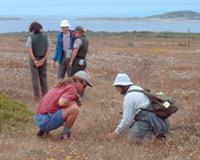Sonoma spineflower facts for kids
Quick facts for kids Sonoma spineflower |
|
|---|---|
 |
|
| Conservation status | |
| Scientific classification | |
| Genus: |
Chorizanthe
|
| Species: |
valida
|
Chorizanthe valida is a very rare flowering plant. It's also called the Sonoma spineflower. This plant belongs to the buckwheat family. It only grows naturally in one small area of Marin County, California, called West Marin. For a while, people thought it was gone forever. But in 1980, a group found it again at Point Reyes National Seashore!
Because it is so rare, the Sonoma spineflower is listed as a federally endangered species. This means it is protected by law to help it survive.
Contents
What is the Sonoma Spineflower?
This plant grows straight up, reaching about 30 centimeters (about 1 foot) tall. Its flowers grow in a cluster. Each tiny flower is surrounded by six reddish or gray leaf-like parts called bracts. Each bract has a straight, pointy tip called an awn.
How Does it Look?
When they are new, the awns are bright red. As they get older, they turn a pretty ivory white. Unlike many other plants in its family, these awns are not hard or hooked. The actual flower is only a few millimeters long. It can be white or pink.

Where Does the Sonoma Spineflower Live?
The Sonoma spineflower used to grow in more places. Many years ago, people found it in nearby Sonoma County. Today, it mostly lives in Point Reyes National Seashore.
Current Locations
There is one natural group of plants at Abbotts Lagoon. Another group has been planted by people near Bull Point. The number of plants changes each year.
Its Special Home
This rare plant lives in a special type of area called a coastal prairie. It grows in deep, sandy soils. These soils are left over from ancient sand dunes. They do not hold much water. Because of this, only plants that can handle dry conditions, called drought-tolerant plants, can grow there.
How Do Animals Affect the Plant?
Scientists have studied how animals affect the Sonoma spineflower. They found something interesting about grazing cattle.
Cattle and the Spineflower
Areas where cattle graze often have more spineflower plants. However, the plants in areas without cattle are usually bigger and have more flowers. Cattle do not eat the Sonoma spineflower. They might even help the plant by clearing away invasive plants. These are plants that are not native to the area and can take over. One example is velvetgrass (Holcus lanatus). The land around Abbotts Lagoon is still used for cattle grazing today.
Protecting the Sonoma Spineflower
The Sonoma spineflower lives inside a protected National Seashore. This means its home will not be built on. It is also safe from activities like mining, digging, and horseback riding.
What Are the Dangers?
Even in a protected area, some threats remain. People hiking and off-road vehicles can sometimes damage the plants. The full effect of cattle on the land is still being studied. They might actually help the rare plant.
Why is it Still at Risk?
Since the plant only lives in two small areas, a single big event could be very dangerous. A large wildfire or a long drought could cause the plant to disappear forever.


